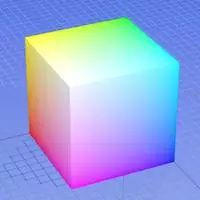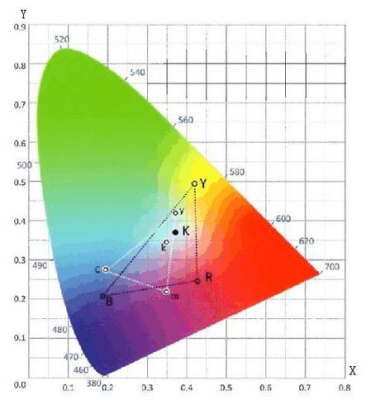Almost all colors can be mixed with three primary colors in a specific proportion. None of the three monochromatic lights can be produced by mixing the other two. In 1931, CIE (International Committee for Standardization of Lighting) established a series of CIE standard chromaticity spaces representing the visible spectrum and defined the CIE-RGB primary color system. It is specified that the wavelengths of the three primary colors of the RGB system are red (R), green (G) and blue (B) at 700nm, 546.1nm and 435.8nm respectively. A group of curves in Figure 1 can be obtained through the color mixing experiment. They show that when the spectral energy is the same in the range of 380nm-780nm, the spectral color mixing results of a certain wavelength are the same, and these three curves are called spectral tristimulus curve. Such RGB can be tested by HSCD-860 spectrophotometer of Shanghai Lishan.
Definition and quantification of color:
Color space: RGB
As early as 1704, Newton proposed that the essence of color is light; In 1854, Glassman summarized Glassman’s law of color mixing; Then in 1855, Maxwell put forward the idea of mixing red, green and blue light to produce various colors.

RGB color space
So can red, green and blue match all colors?
This question depends on “whether all colors can be divided into red, yellow and blue combinations”. That is, can the combination of red, yellow and blue light produce all the colors that human beings can perceive?
Then the scientists began various experiments, and finally found that the answer was: yes, but not.
Through the test, after the spectrum of a specific color is obtained, the intensity value of each wavelength of the color is known, and the intensity value of the equivalent trichromatic light (RGB) is also known.
In this way, we have the matching ratio of RGB trichromatic light equivalent to this specific spectrum.
This ratio can be used to roughly quantify the color.
The ratio after normalization is the so-called chromaticity coordinate.
In this way, all colors in nature can be distinguished by human eyes. As long as you can distinguish the color, you can use this method to quantify. Although color can also be described (uniquely) by spectral curve! From 780 nm to 380 nm, the number is huge and very not intuitive!
Such naming is unrealistic. Therefore, not all colors can be divided into red, yellow and blue combinations.
However, if the RGB ratio value is used for naming, only three data are needed (after normalization, only two data are needed).
It took three hundred years for mankind to reach this point.
On this basis, another mathematical coordinate transformation is carried out (coordinate is changed from rgb to xyz)
This is the CIE 1931 XYZ chromaticity diagram we usually see.
Of course, in this way, the “brightness” information contained in the tristimulus value is completely lost, leaving only the information of relative ratio. So CIE 1931 XYZ chromaticity diagram can only see the information of chromaticity (hue, saturation), but not brightness.

CIEXYZ color space
Color space: Munsell
In 1905, the American painter Munsell summarized the experience and research results of color scientists for two centuries and put forward the color system.

Munsell color space
Munsell color classification method belongs to pure psychological color classification method. Its three-dimensional space represents three basic visual parameters of color, namely brightness, hue and saturation.
As the real color samples of Munsell color system, Munsell atlas has been widely used in various color-related industrial production and color scientific research such as textile, dye, paint, ink, medicine, chemistry, photography, color television, etc.
Color space: CIE Lab and CIE Luv
In order to measure and evaluate color differences more objectively and accurately, CIE formally proposed two improved uniform color spaces in 1976, namely CIE1976L * u * v color space and CIE1976L * a * b color space. The two values can be converted to each other. In particular, CIE1976L * a * b color space was the color space with good effect at that time, and was widely used.
L means bright and dark,+means slightly bright, – means slightly dark; A is red and green,+is red and – is green; B is yellow and blue,+is yellow and – is blue.
Color space: LCh, CMYK, etc
Now there are still many color spaces in different industries. For example: LCh, CMYK, Hunterlab, etc. L is the brightness value, C is the color saturation, and h is the hue angle.
Benchtop Spectrophotometer (Transmittance) DSCD-910 is good performance and specially designed for testing the transparent material’s transmittance, absorbance, chromaticity value and other parameters.
The instrument adopts the geometry of D/0, integration of the full band LED composite light source, double beam optical system, ETC every-test calibration technology, which makes the instrument reaches a resolution of 0.0001, deviation of the transmittance within 0.08% and chromatic value △E*ab 0.015.
Lisun Instruments Limited was found by LISUN GROUP in 2003. LISUN quality system has been strictly certified by ISO9001:2015. As a CIE Membership, LISUN products are designed based on CIE, IEC and other international or national standards. All products passed CE certificate and authenticated by the third party lab.
Our main products are Goniophotometer, Integrating Sphere, Spectroradiometer, Surge Generator, ESD Simulator Guns, EMI Receiver, EMC Test Equipment, Electrical Safety Tester, Environmental Chamber, Temperature Chamber, Climate Chamber, Thermal Chamber, Salt Spray Test, Dust Test Chamber, Waterproof Test, RoHS Test (EDXRF), Glow Wire Test and Needle Flame Test.
Please feel free to contact us if you need any support.
Tech Dep: Service@Lisungroup.com, Cell/WhatsApp:+8615317907381
Sales Dep: Sales@Lisungroup.com, Cell/WhatsApp:+8618117273997
Your email address will not be published. Required fields are marked *